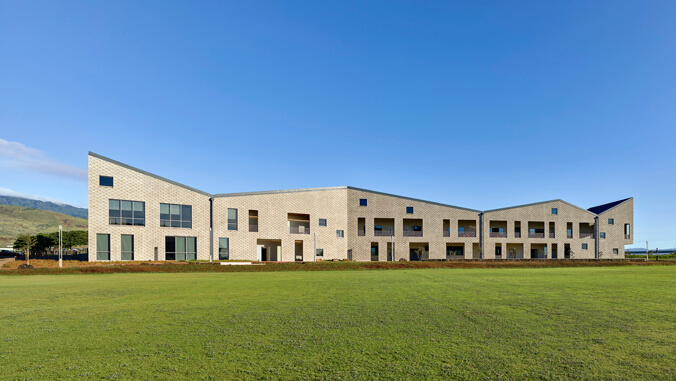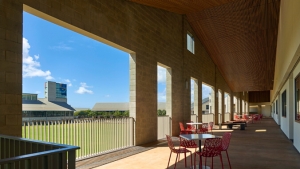
A new addition to the lobby of the Administration and Health Sciences (AHS) Building at the University of Hawaiʻi–West Oʻahu is as aesthetic as it is exceptional.
The glass plaque from the U.S. Green Building Council (USGBC) indicates the AHS Building’s noteworthy Leadership in Energy and Environmental Design (LEED) certification, a globally recognized symbol of sustainability achievement and leadership, and the most widely used green building rating system in the world. “The significance here is that the project exceeds the UH criteria for new buildings to strive to meet LEED Silver,” said Bonnie Arakawa, director of planning, facilities, capital improvement project and land at UH West Oʻahu. “The goal is to develop buildings in a way that will address sustainability from the design, maintenance and fiscal standpoints in both the short- and long-terms. Reaching gold was a byproduct of that effort.”

The AHS Building was gold-certified on June 16, and its new plaque was installed on September 2 in the lobby of the administration wing.
According to the USGBC website, projects pursuing LEED certification earn points for green building strategies across several categories. Based on the number of points achieved, a project earns one of four LEED rating levels: certified, silver, gold or platinum.
Among the AHS Building’s green features:
- The ecological design and construction work included bioretention systems and rainwater catchment for managing stormwater onsite and the construction of an onsite greywater treatment system treating the building sink water and condensate recovery for reuse as subsurface drip irrigation.
- All the water conservation gardens are interactive and can be utilized as educational features by both the campus students and staff.
- To reduce energy consumption, the building features an 89 kW DC photovoltaic system on the rooftop, high efficiency HVAC systems and 100% LED lighting.
- An astounding 97% of regularly occupied spaces are naturally daylit and 96% of those spaces have access to outdoor views of the beautiful Waiʻanae mountains and ʻEwa plains. Natural light is more pleasing, healthful and psychologically beneficial than artificial light. Daylight is also a highly cost-effective means of reducing the energy for electrical lighting.
Previous ratings of UH West Oʻahu buildings include LEED Gold for the James & Abigail Campbell Library and LEED Silver for the Campus Center, Laboratory and Classroom buildings.
Read more in Ka Puna O Kaloʻi.
—By Zenaida Serrano Arvman

